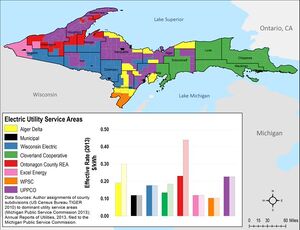J.M.Pearce (talk | contribs) mNo edit summary |
Sophivorus (talk | contribs) m (Text replacement - "| affiliations = " to "| organizations = ") |
||
| (32 intermediate revisions by 7 users not shown) | |||
| Line 1: | Line 1: | ||
{{Solar menu}} | |||
{{MOST}} | {{MOST}} | ||
==Highlights== | {{Pearce pubs menu}} | ||
[[File:Grid-defect-biz.png|thumb]] | |||
{{Source data | |||
| type = Paper | |||
| cite-as = Trevor B. Peffley & Joshua M.Pearce. The Potential for Grid Defection of Small and Medium Sized Enterprises Using Solar Photovoltaic, Battery and Generator Hybrid Systems. ''Renewable Energy''. 148, (2020), pp. 193-204. https://doi.org/10.1016/j.renene.2019.12.039 [https://www.academia.edu/41243981/The_Potential_for_Grid_Defection_of_Small_and_Medium_Sized_Enterprises_Using_Solar_Photovoltaic_Battery_and_Generator_Hybrid_Systems open access] | |||
| location = Michigan, USA | |||
}} | |||
[[File:Upmap.jpg|thumb]] | |||
Grid-tied solar photovoltaic (PV) systems enable lower cost electricity for small and medium size enterprises (SMEs) than they are currently paying for grid electricity in the U.S. These economic realities threaten conventional electric utilities, which have begun manipulating rate structures to reduce the profitability of distributed generation (DG), as well as putting arbitrary caps on DG in their service territories. SMEs may reduce electricity costs, if they can grid defect with hybrid captive power systems made up of solar, battery and generator subsystems. This paper analyzes the technical and economic viability for hybrid solar systems deployed in the commercial sector to enable self-generation. Specifically, for the first time, the economics of grid defection are analyzed for three case studies of SMEs in the northern U.S., which represent a challenging technical case because of long dark winters, but also have high utility costs. The results of the simulations make it clear that grid defection is already viable for SMEs with the current prices for all components in the solar hybrid system. These results were consistent across scale, load-profile, and utility rate. These economic projections included no government incentives or subsidies and can thus be considered extremely conservative for the specific case studies. Policy changes are discussed for electric utilities to avoid the potential of a utility death spiral in this and similar performing locations. | |||
== Highlights == | |||
* Northern US small & medium size enterprises (SMEs) self generation economics | * Northern US small & medium size enterprises (SMEs) self generation economics | ||
| Line 14: | Line 25: | ||
* Grid defection is slightly sensitive to natural gas costs | * Grid defection is slightly sensitive to natural gas costs | ||
== See also == | |||
* [[Emerging economic viability of grid defection in a northern climate using solar hybrid systems]] | * [[Emerging economic viability of grid defection in a northern climate using solar hybrid systems]] | ||
* [[Levelized cost of electricity for solar photovoltaic, battery and cogen hybrid systems]] | * [[Levelized cost of electricity for solar photovoltaic, battery and cogen hybrid systems]] | ||
| Line 31: | Line 35: | ||
* [[Simulations of Greenhouse Gas Emission Reductions from Low-Cost Hybrid Solar Photovoltaic and Cogeneration Systems for New Communities]] | * [[Simulations of Greenhouse Gas Emission Reductions from Low-Cost Hybrid Solar Photovoltaic and Cogeneration Systems for New Communities]] | ||
* [[Photovoltaic plus combined heat and power]] | * [[Photovoltaic plus combined heat and power]] | ||
* [[PV and CHP | * [[PV and CHP Literature review]] | ||
* [[Policies to Overcome Barriers for Renewable Energy Distributed Generation: A Case Study of Utility Structure and Regulatory Regimes in Michigan]] | * [[Policies to Overcome Barriers for Renewable Energy Distributed Generation: A Case Study of Utility Structure and Regulatory Regimes in Michigan]] | ||
* [[Economic viability of captive off-grid solar photovoltaic and diesel hybrid energy systems for the Nigerian private sector]] | * [[Economic viability of captive off-grid solar photovoltaic and diesel hybrid energy systems for the Nigerian private sector]] | ||
* [[A review of the value of solar methodology with a case study of the U.S. VOS]] | |||
* [http://www.renewableenergyworld.com/articles/2017/01/new-utility-program-helps-customers-go-off-grid.html Vermont Utility helping customers leave the grid for fixed monthly fee] | * [http://www.renewableenergyworld.com/articles/2017/01/new-utility-program-helps-customers-go-off-grid.html Vermont Utility helping customers leave the grid for fixed monthly fee] | ||
* [[Examining interconnection and net metering policy for distributed generation in the United States]] | * [[Examining interconnection and net metering policy for distributed generation in the United States]] | ||
* [[Economic viability of captive off-grid solar photovoltaic and diesel hybrid energy systems for the Nigerian private sector]] | * [[Economic viability of captive off-grid solar photovoltaic and diesel hybrid energy systems for the Nigerian private sector]] | ||
* [[Energy Policy for Energy Sovereignty: Can policy tools enhance energy sovereignty?]] | |||
* [[The energy crises revealed by COVID: Intersections of Indigeneity, inequity, and health]] | |||
* [[Decentralized Renewable Hybrid Mini-Grids for Rural Communities: Culmination of the IREP Framework and Scale up to Urban Communities]] | |||
* [[Demonstration of the integrated rural energy planning framework for sustainable energy development in low-income countries: Case studies of rural communities in Nigeria]] | |||
* [[Applying a Relationally and Socially Embedded Decision Framework to Solar Photovoltaic Adoption: A Conceptual Exploration]] | |||
* [[Economics of Grid-Tied Solar Photovoltaic Systems Coupled to Heat Pumps: The Case of Northern Climates of the U.S. and Canada]] | |||
* [[Decarbonizing rural residential buildings in cold climates: A techno-economic analysis of heating electrification]] | |||
* [[Strategic Investment in Open Hardware for National Security]] | |||
* [[Achieving 100% Renewable and Self-Sufficient Electricity in Impoverished, Rural, Northern Climates: Case Studies from Upper Michigan, USA]] | |||
* [[Open source decarbonization for a sustainable world]] | |||
* [[Can grid-tied solar photovoltaics lead to residential heating electrification? A techno-economic case study in the midwestern U.S.]] | |||
* http://www.utilityratewatch.org/ | |||
* Gorman, W., Jarvis, S. and Callaway, D., 2020. Should I Stay Or Should I Go? The importance of electricity rate design for household defection from the power grid. Applied Energy, 262, p.114494. https://doi.org/10.1016/j.apenergy.2020.114494 (2016 data no energy cost escalation) | |||
* Grid defection 2022 CA https://www.sanjuandailystar.com/post/frustrated-with-utilities-some-californians-are-leaving-the-grid | |||
* [[A Free and open-source microgrid optimization tool: SAMA the Solar Alone Multi-Objective Advisor]] | |||
{{Page data | |||
| title-tag = Grid Defection of SMEs: Solar PV, Battery, & Generators | |||
| part-of = MOST completed projects and publications | |||
| keywords = Photovoltaics, Solar energy, Cogeneration, Electricity, Energy production, Heating and cooling, Heating, Cooling, Energy policy, Electric utility, Photovoltaic, Distributed generation, off-grid, hybrid system, battery, grid defection, autoproduction, captive power | |||
| sdg = SDG07 Affordable and clean energy | |||
| organizations = MOST | |||
| authors = Trevor B. Peffley, J.M.Pearce | |||
}} | |||
[[Category:Photovoltaics]] | [[Category:Photovoltaics]] | ||
[[Category:Solar energy]] | [[Category:Solar energy]] | ||
[[Category: | [[Category:Electricity]] | ||
[[Category: | [[Category:Energy production]] | ||
[[Category:Heating and cooling]] | |||
[[Category:Energy policy]] | |||
Latest revision as of 15:06, 28 February 2024


Grid-tied solar photovoltaic (PV) systems enable lower cost electricity for small and medium size enterprises (SMEs) than they are currently paying for grid electricity in the U.S. These economic realities threaten conventional electric utilities, which have begun manipulating rate structures to reduce the profitability of distributed generation (DG), as well as putting arbitrary caps on DG in their service territories. SMEs may reduce electricity costs, if they can grid defect with hybrid captive power systems made up of solar, battery and generator subsystems. This paper analyzes the technical and economic viability for hybrid solar systems deployed in the commercial sector to enable self-generation. Specifically, for the first time, the economics of grid defection are analyzed for three case studies of SMEs in the northern U.S., which represent a challenging technical case because of long dark winters, but also have high utility costs. The results of the simulations make it clear that grid defection is already viable for SMEs with the current prices for all components in the solar hybrid system. These results were consistent across scale, load-profile, and utility rate. These economic projections included no government incentives or subsidies and can thus be considered extremely conservative for the specific case studies. Policy changes are discussed for electric utilities to avoid the potential of a utility death spiral in this and similar performing locations.
Highlights[edit | edit source]
- Northern US small & medium size enterprises (SMEs) self generation economics
- Grid defection via hybrid solar photovoltaic, battery & generator technically viable
- At current costs grid defection with solar hybrid system profitable
- Utilities can encourage distributed generation to prevent utility death spiral
- Grid defection is slightly sensitive to natural gas costs
See also[edit | edit source]
- Emerging economic viability of grid defection in a northern climate using solar hybrid systems
- Levelized cost of electricity for solar photovoltaic, battery and cogen hybrid systems
- Performance of U.S. hybrid distributed energy systems: Solar photovoltaic, battery and combined heat and power
- Review of solar levelized cost
- PV and CHP Hybrid System
- Hybrid photovoltaic-trigeneration systems
- Simulations of Greenhouse Gas Emission Reductions from Low-Cost Hybrid Solar Photovoltaic and Cogeneration Systems for New Communities
- Photovoltaic plus combined heat and power
- PV and CHP Literature review
- Policies to Overcome Barriers for Renewable Energy Distributed Generation: A Case Study of Utility Structure and Regulatory Regimes in Michigan
- Economic viability of captive off-grid solar photovoltaic and diesel hybrid energy systems for the Nigerian private sector
- A review of the value of solar methodology with a case study of the U.S. VOS
- Vermont Utility helping customers leave the grid for fixed monthly fee
- Examining interconnection and net metering policy for distributed generation in the United States
- Economic viability of captive off-grid solar photovoltaic and diesel hybrid energy systems for the Nigerian private sector
- Energy Policy for Energy Sovereignty: Can policy tools enhance energy sovereignty?
- The energy crises revealed by COVID: Intersections of Indigeneity, inequity, and health
- Decentralized Renewable Hybrid Mini-Grids for Rural Communities: Culmination of the IREP Framework and Scale up to Urban Communities
- Demonstration of the integrated rural energy planning framework for sustainable energy development in low-income countries: Case studies of rural communities in Nigeria
- Applying a Relationally and Socially Embedded Decision Framework to Solar Photovoltaic Adoption: A Conceptual Exploration
- Economics of Grid-Tied Solar Photovoltaic Systems Coupled to Heat Pumps: The Case of Northern Climates of the U.S. and Canada
- Decarbonizing rural residential buildings in cold climates: A techno-economic analysis of heating electrification
- Strategic Investment in Open Hardware for National Security
- Achieving 100% Renewable and Self-Sufficient Electricity in Impoverished, Rural, Northern Climates: Case Studies from Upper Michigan, USA
- Open source decarbonization for a sustainable world
- Can grid-tied solar photovoltaics lead to residential heating electrification? A techno-economic case study in the midwestern U.S.
- http://www.utilityratewatch.org/
- Gorman, W., Jarvis, S. and Callaway, D., 2020. Should I Stay Or Should I Go? The importance of electricity rate design for household defection from the power grid. Applied Energy, 262, p.114494. https://doi.org/10.1016/j.apenergy.2020.114494 (2016 data no energy cost escalation)
- Grid defection 2022 CA https://www.sanjuandailystar.com/post/frustrated-with-utilities-some-californians-are-leaving-the-grid
- A Free and open-source microgrid optimization tool: SAMA the Solar Alone Multi-Objective Advisor





